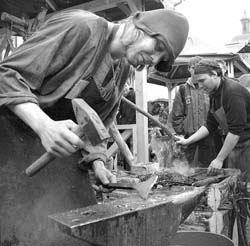Man and metal
The First International Blacksmith Festival gathers 260 artisans from various countries
In an hour and a half the central square of Ivano-Frankivsk turned into one big smithy. This city in western Ukraine attracted first-class blacksmiths from 17 countries and 17 oblasts of Ukraine to present the art of their trade and show that metal has a soul. The idea of gathering amateur and professional blacksmiths belongs to the Council of the Carpathian Region and the Association of Master Blacksmiths of Ukraine. Both organizations made every effort to stage the 1 st International Blacksmith Festival in Ivano-Frankivsk on the anniversary of the city’s founding. A total of 260 guests from various countries agreed to take part in the “metal fest.”
Most of the leading blacksmiths, artists, and sculptors came from Holland, the United Kingdom, Austria, and Germany. The Ukrainian side was mainly represented by artisans from Donetsk oblast and the city of Ivano-Frankivsk. According to the association’s head Serhiy Polubotok, certain southern and central territories of Ukraine failed to take part in the event. “This by no means indicates that smithery is underdeveloped in Poltava or Kherson oblasts. It’s just that we had no time to get our idea across there,” he explained.
IVANO-FRANKIVSK — DONETSK
Ukrainians borrowed the idea of a blacksmith festival from Europe, where such festivals are held several times a year. Their blacksmiths know each other by name and reputation, whether they live in Germany or Holland. “We have a friendly blacksmith family that embraces artisans of various nationalities and religions. We would be happy to accept Ukrainians as members of this family,” promised Kees Pronk, president of the Mondra Group of international designers and blacksmiths.
The blacksmith festival is being staged in the Subcarpathian region for the fourth year in a row. This time it was organized on a markedly broad scale, both in the material and moral sense, as the festival served to unite the eastern and western parts of Ukraine. Viktor Burduk, the director of a Donetsk Ukrainian smithery known as Hefest, became a partner of the festival, and participants were provided with raw materials by the Metallurgical Works of Alchevsk.
The friendship between Donetsk and Ivano-Frankivsk is not accidental. Two years ago Polubotok visited Donetsk to attend a miners’ festival. Every year on this date local blacksmiths stage a mini-festival in honor of their trade. “These traditions have long been lost in eastern Ukraine. We are in the process of reviving them,” says Burduk. There is even a park featuring monumental sculptures donated by blacksmiths during every festival. There are not many sculptures now, just 60, but Burduk predicts that in five years there will be nearly 500.
SKIRTS, VARENYKY, AND FLOWERS
For two days Sheptytsky Square echoed with the banging and clanking of metal being turned into works of art with the aid of fire and hammer. During the festival the visiting blacksmiths proved that nothing is impossible. Who would have thought of making varenyky out of metal, stuffed not with potatoes or cabbage but with bolts and screws? While visitors watched the blacksmiths, they were served real varenyky stuffed with potatoes, bought at a nearby supermarket. After their “culinary” endeavors the blacksmiths wanted to demonstrate something even more creative and for one hour they became fashion trendsetters. It turns out that metal can produce decent skirts. The smithies even hired a model to wear their “garments” on the square. Although she couldn’t walk down a catwalk, she tried on a few metal skirts. After the artisans had their fun, they got down to business. All the blacksmiths who took part in the festival were involved in a monumental project called “Master Bouquet” to transform a heap of metal into flowers of various shapes and designs. Every festival participant made a “twig,” adding to what would soon become a five-meter-high “bouquet.” The blacksmiths presented the bouquet to Ivano-Frankivsk to commemorate the city’s anniversary.
The festival also featured a blacksmiths’ trade fair, where visitors could buy a metal souvenir for ten hryvnias. Among the most popular items were horseshoes. Every visitor could try his hand at the forge when the Ukrainian and visiting artisans were conducting master classes.
BRIDGES OF FRIENDSHIP
Even though the art of blacksmithing was revived in Europe several decades ago, Ukrainian artisans also had much to offer their foreign guests, and our metalwork left them speechless with admiration. The guests promptly reciprocated. Some of the visiting blacksmiths arrived at the festival with their apprentices, including girls. “What makes you think that blacksmithing is a purely male preserve? It’s the same kind of creative endeavor as any other. Metal can serve to create great sculptures; the main thing is to put one’s heart into the job,” said Huub Sensen. One of his female apprentices produced a metal sculpture of a woman’s body.
The visiting blacksmiths’ invitation to their Ukrainian counterparts to “join the family” is not all talk. In 1996 the Artist Blacksmiths’ Association decided to build “bridges of friendship” with certain countries. One such work of art is in the United States, where the halves of the friendship bridge face each other across the Atlantic. The next “bridge” will be aimed at Japan. Some Ukrainian blacksmiths have been invited to take part in this project. “We are showing what blacksmithing is all about. It’s our passion, mood, and inspiration. I don’t know what will happen if we fail to visit Ukraine next year,” says Huub Sensen.






